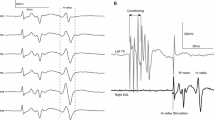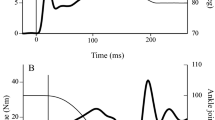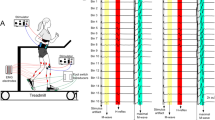Abstract
During rhythmic arm cycling, soleus H-reflex amplitudes are reduced by modulation of group Ia presynaptic inhibition. This suppression of reflex amplitude is graded to the frequency of arm cycling with a threshold of 0.8 Hz. Despite the data on modulation of the soleus H-reflex amplitude induced by rhythmic arm cycling, comparatively little is known about the modulation of stretch reflexes due to remote limb movement. Therefore, the present study was intended to explore the effect of arm cycling on stretch and H-reflex amplitudes in the soleus muscle. In so doing, additional information on the mechanism of action during rhythmic arm cycling would be revealed. Although both reflexes share the same afferent pathway, we hypothesized that stretch reflex amplitudes would be less suppressed by arm cycling because they are less inhibited by presynaptic inhibition. Failure to reject this hypothesis would add additional strength to the argument that Ia presynaptic inhibition is the mechanism modulating soleus H-reflex amplitude during rhythmic arm cycling. Participants were seated in a customized chair with feet strapped to footplates. Three motor tasks were performed: static control trials and arm cycling at 1 and 2 Hz. Soleus H-reflexes were evoked using single 1 ms pulses of electrical stimulation delivered to the tibial nerve at the popliteal fossa. A constant M-wave and ~6% MVC activation of soleus were maintained across conditions. Stretch reflexes were evoked using a single sinusoidal pulse at 100 Hz given by a vibratory shaker placed over the triceps surae tendon and controlled by a custom-written LabView program. Results demonstrated that rhythmic arm cycling that was effective for conditioning soleus H-reflexes did not show a suppressive effect on the amplitude of the soleus stretch reflex. We suggest this indicates that stretch reflexes are less sensitive to conditioning by rhythmic arm movement, as compared to H-reflexes, due to the relative insensitivity to Ia presynaptic inhibition.




Similar content being viewed by others
References
Aymard C, Katz R, Lafitte C, Lo E, Penicaud A, Pradat-Diehl P, Raoul S (2000) Presynaptic inhibition and homosynaptic depression—a comparison between lower and upper limbs in normal human subjects and patients with hemiplegia. Brain 123:1688–1702
Baldissera F, Hultborn H, Illert M (1981) Integration in spinal neuronal system. Handbook of physiology. The nervous system. Motor control. American Physiological Society, Washington, DC, pp 509–595
Barzi Y, Zehr EP (2008) Rhythmic arm cycling suppresses hyperactive soleus H-reflex amplitude after stroke. Clin Neurophysiol 119:1443–1452. doi:10.1016/j.clinph.2008.02.016
Bergmans J, Delwaide PJ, Gadea-Ciria M (1978) Short-latency effects of low-threshold muscular afferent fibers on different motoneuronal pools of the lower limb in man. Exp Neurol 60:380–385
Brooke JD, Cheng J, Collins DF, McIlroy WE, Misiaszek JE, Staines WR (1997) Sensori-sensory afferent conditioning with leg movement: gain control in spinal reflex and ascending paths. Prog Neurobiol 51:393–421
Burke D, McKeon B, Skuse NF (1981) Dependence of the Achilles tendon reflex on the excitability of spinal reflex pathways. Ann Neurol 10:551–556. doi:10.1002/ana.410100610
Burke D, Gandevia SC, McKeon B (1983) The afferent volleys responsible for spinal proprioceptive reflexes in man. J Physiol 339:535–552
Burke D, Gandevia SC, McKeon B (1984) Monosynaptic and oligosynaptic contributions to human ankle jerk and H-reflex. J Neurophysiol 52:435–448
Burke D, Adams RW, Skuse NF (1989) The effects of voluntary contraction on the H reflex of human limb muscles. Brain 112(Pt 2):417–433
Capaday C, Stein RB (1986) Amplitude modulation of the soleus H-reflex in the human during walking and standing. J Neurosci 6:1308–1313
Cavallari P, Edgley SA, Jankowska E (1987) Post-synaptic actions of midlumbar interneurones on motoneurones of hind-limb muscles in the cat. J Physiol 389:675–689
Crenna P, Frigo C (1987) Excitability of the soleus H-reflex arc during walking and stepping in man. Exp Brain Res 66(1):49–60
Crone C, Nielsen J (1994) Central control of disynaptic reciprocal inhibition in humans. Acta Physiol Scand 152:351–363
de Ruiter GC, Hundza SR, Zehr EP (2010) Phase-dependent modulation of soleus H-reflex amplitude induced by rhythmic arm cycling. Neurosci Lett 475:7–11. doi:10.1016/j.neulet.2010.03.025
Dietz V (2002) Do human bipeds use quadrupedal coordination? Trends Neurosci 25:462–467
Enriquez-Denton M, Morita H, Christensen LO, Petersen N, Sinkjaer T, Nielsen JB (2002) Interaction between peripheral afferent activity and presynaptic inhibition of Ia afferents in the cat. J Neurophysiol 88:1664–1674
Fornari MC, Kohn AF (2008) High frequency tendon reflexes in the human soleus muscle. Neurosci Lett 440:193–196. doi:10.1016/j.neulet.2008.05.075
Frigon A, Collins DF, Zehr EP (2004) Effect of rhythmic arm movement on reflexes in the legs: modulation of soleus H-reflexes and somatosensory conditioning. J Neurophysiol 91:1516–1523. doi:10.1152/jn.00695.2003
Funase K, Miles TS (1999) Observations on the variability of the H reflex in human soleus. Muscle Nerve 22:341–346
Gernandt BE, Megiriand D (1961) Ascending propriospinal mechanisms. J Neurophysiol 24:364–376
Gernandt BE, Shimamura M (1961) Mechanisms of interlimb reflexes in cat. J Neurophysiol 24:665–676
Gregory JE, Wise AK, Wood SA, Prochazka A, Proske U (1998) Muscle history, fusimotor activity and the human stretch reflex. J Physiol 513(Pt 3):927–934
Hultborn H, Meunier S, Morin C, Pierrot-Deseilligny E (1987a) Assessing changes in presynaptic inhibition of Ia fibres: a study in man and the cat. J Physiol 389:729–756
Hultborn H, Meunier S, Pierrot-Deseilligny E, Shindo M (1987b) Changes in presynaptic inhibition of Ia fibres at the onset of voluntary contraction in man. J Physiol 389:757–772
Hundza SR, Zehr EP (2009) Suppression of soleus H-reflex amplitude is graded with frequency of rhythmic arm cycling. Exp Brain Res 193:297–306. doi:10.1007/s00221-008-1625-0
Jendrassik E (1883) Beitrage zur Lehre von den Sehnenreflexen. Deutsche Archiv fur Klinische Medizin 33:177–199
Kao PC, Ferris DP (2005) The effect of movement frequency on interlimb coupling during recumbent stepping. Mot Control 9:144–163
Klimstra MD, Thomas E, Stoloff RH, Ferris DP, Zehr EP (2009) Neuromechanical considerations for incorporating rhythmic arm movement in the rehabilitation of walking. Chaos 19:026102. doi:10.1063/1.3147404
Loadman PM, Zehr EP (2007) Rhythmic arm cycling produces a non-specific signal that suppresses soleus H-reflex amplitude in stationary legs. Exp Brain Res 179:199–208. doi:10.1007/s00221-006-0782-2
Meunier S, Pierrot-Deseilligny E, Simonetta M (1993) Pattern of monosynaptic heteronymous Ia connections in the human lower limb. Exp Brain Res 96:534–544
Mezzarane RM, Nakajima T, Zehr EP (submitted) Modulation of soleus stretch reflex amplitude during rhythmic arm cycling movement after stroke. Clin Neurophysiol (under review)
Morita H, Petersen N, Christensen LO, Sinkjaer T, Nielsen J (1998) Sensitivity of H-reflexes and stretch reflexes to presynaptic inhibition in humans. J Neurophysiol 80:610–620
Nielsen J, Petersen N, Crone C (1995) Changes in transmission across synapses of Ia afferents in spastic patients. Brain 118:995–1004
Petersen N, Morita H, Nielsen J (1998) Evaluation of reciprocal inhibition of the soleus H-reflex during tonic plantar flexion in man. J Neurosci Methods 84:1–8
Pierrot-Deseilligny E, Mazevet D (2000) The monosynaptic reflex: a tool to investigate motor control in humans. Interest and limits. Neurophysiol Clin 30:67–80
Pierrot-Deseilligny E, Burke D (2005) The circuitry of the human spinal cord: its role in motor control and movement disorders. Cambridge University Press, London
Shimba S, Kawashima N, Ohta Y, Yamamoto S, Nakazawa K (2010) Enhanced stretch reflex excitability in the soleus muscle during passive standing posture in humans. J Electromyogr Kinesiol 20:406–412. doi:10.1016/j.jelekin.2009.04.003
Sinkjaer T, Andersen JB, Larsen B (1996) Soleus stretch reflex modulation during gait in humans. J Neurophysiol 76:1112–1120
Stein RB (1995) Presynaptic inhibition in humans. Prog Neurobiol 47:533–544
Stein RB, Yang JF, Belanger M, Pearson KG (1993) Modification of reflexes in normal and abnormal movements. Prog Brain Res 97:189–196
Tanaka R (1974) Reciprocal Ia inhibition during voluntary movements in man. Exp Brain Res 21:529–540
Zehr EP (2002) Considerations for use of the Hoffmann reflex in exercise studies. Eur J Appl Physiol 86:455–468
Zehr EP, Duysens J (2004) Regulation of arm and leg movement during human locomotion. Neuroscientist 10:347–361
Zehr EP, Haridas C (2003) Modulation of cutaneous reflexes in arm muscles during walking: further evidence of similar control mechanisms for rhythmic human arm and leg movements. Exp Brain Res 149:260–266
Zehr EP, Stein RB (1999) Interaction of the Jendrassik maneuver with segmental presynaptic inhibition. Exp Brain Res 124:474–480
Zehr EP, Collins DF, Frigon A, Hoogenboom N (2003) Neural control of rhythmic human arm movement: phase dependence and task modulation of Hoffmann reflexes in forearm muscles. J Neurophysiol 89:12–21
Zehr EP, Hoogenboom N, Frigon A, Collins DF (2004) Facilitation of soleus H-reflex amplitude evoked by cutaneous nerve stimulation at the wrist is not suppressed by rhythmic arm movement. Exp Brain Res 159:382–388
Acknowledgments
This work was supported by grants to E. P. Z. from the Heart and Stroke Foundation of Canada (BC & Yukon) and the Natural Sciences and Engineering Research Council of Canada (NSERC). The authors thank Drs. Rinaldo Mezzarane and Tsuyoshi Nakajima for help during the experiments.
Author information
Authors and Affiliations
Corresponding author
Rights and permissions
About this article
Cite this article
Palomino, A.F., Hundza, S.R. & Zehr, E.P. Rhythmic arm cycling differentially modulates stretch and H-reflex amplitudes in soleus muscle. Exp Brain Res 214, 529–537 (2011). https://doi.org/10.1007/s00221-011-2851-4
Received:
Accepted:
Published:
Issue Date:
DOI: https://doi.org/10.1007/s00221-011-2851-4




